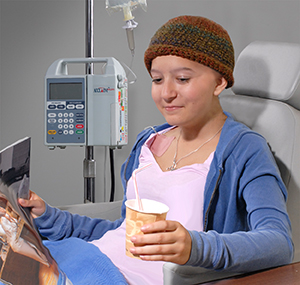When Your Child Has Acute Lymphoblastic Leukemia (ALL)
Your child has been diagnosed with acute lymphoblastic leukemia (ALL). It's also called acute lymphocytic leukemia. ALL is a common type of blood cancer in children. It's often cured with treatment. Your child’s healthcare team will help you as you make important decisions about your child’s health. Read on to learn more about ALL and how it's treated.
What is ALL?
ALL is a fast-growing cancer that affects the bone marrow and blood. Bone marrow is the spongy tissue inside bones where new blood cells are made. Blood is made up of three main types of cells:
-
White blood cells that fight infection
-
Red blood cells that carry oxygen throughout the body, which gives a person energy
-
Platelets that help the blood to clot, which helps stop bleeding
When a person is healthy, white blood cells are made and mature in the bone marrow. With ALL, large numbers of abnormal, immature white blood are made. These cells are called leukemic blasts. They crowd out healthy cells in the bone marrow. As time goes on, there are more blasts than healthy cells. Then, normal blood cells can't be made and the blood can’t do its job. In this way, ALL affects all of the blood cells. This can lead to problems like infection and bleeding. Anemia can also occur. This is when there aren't enough red blood cells in the body.
Who gets ALL?
ALL is the most common type of childhood cancer. It's most common in younger children. But it can happen at any age. ALL is not contagious, so your child can’t pass it to another person.
What causes ALL?
ALL occurs when certain types of white blood cells, called lymphocytes, grow out of control. Healthcare professionals don't know what causes this to happen. In rare cases, certain inherited conditions or exposure to certain chemicals might play a role. But most often, the cause of leukemia in children is unknown.
What are the symptoms of ALL?
Some common symptoms of ALL are:
Your child may have some of these symptoms, or other symptoms.
How is ALL diagnosed?
Your child’s healthcare provider will examine your child. You will be asked about your child’s health history and symptoms. You child may have one or more of these:
-
Blood tests. These are done to check the number of different blood cells and look at them under a microscope.
-
Imaging tests. Your child may have a test, such as a chest X-ray, to take detailed images of areas inside the body. This is done to see if the leukemia cells have formed a mass in the chest, or to check for signs of infection.
-
Bone marrow aspiration and biopsy. This is done to take bone marrow from the hipbone so it can be tested in a lab.
-
Lumbar puncture. This is also called a spinal tap. A needle is put in your child’s lower back to take out some of the fluid that surrounds the spinal cord so it can be checked for cancer cells.
How is ALL treated?
Chemotherapy (chemo) is the main treatment for ALL. Chemo uses strong medicines that kill cancer cells. Treatment is a combination of chemo and other supportive medicines. They may be given by mouth, injection, or right into the blood through a tube (IV) that’s put into a vein in the arm or chest.
For some children who are at higher risk for ALL coming back, high-dose chemo may be given along with a stem cell transplant. In certain cases, other treatments like radiation therapy may be used. There are newer treatments available for some children with ALL that has returned after treatment. Your child’s healthcare provider can tell you more.

The treatment for ALL uses cancer-fighting medicines called chemotherapy to destroy cancer cells.
Supportive treatments
The goal of supportive treatments is to protect your child from infection, ease discomfort, and help keep blood counts in a healthy range. For instance, during your child’s treatment, they may be given antibiotics. These help prevent and fight infection. Anti-nausea medicine, pain medicine, and other medicines may also be given. These help ease side effects caused by chemo. Your child may get blood product transfusions to replace blood cells destroyed by treatment.
What are the long-term concerns?
With treatment, ALL is usually cured. But chemo and radiation therapy can cause long-lasting problems, such as damage to certain organs. Your child’s health will need to be closely watched during and after treatment. This may involve clinic visits, blood tests, and other follow-up monitoring.
When should I call my child's healthcare provider?
Call the healthcare provider right away if your child has any of these:
-
Fever of 100.4°F (38.0°C) or higher, or as advised by the provider
-
Seizure
-
Chills
-
Cough
-
Pain that can’t be controlled
-
Uncontrolled nausea or vomiting
-
Weakness
-
Diarrhea
Talk with your child's healthcare provider about what you should watch for and when you should call. Ask how to reach the healthcare provider after office hours and on weekends.
Coping
It's scary and confusing to find out your child has cancer. Remember that you are not alone. Your child’s healthcare team will work with you and your child throughout your child’s illness and care. You may also wish to seek information and support for yourself. Doing so can help you cope with the changes cancer brings to you, your child, and your family. Learning about and talking with others who also have a child with cancer may help you and your family cope. Some helpful resources are: